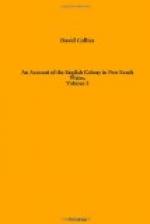The male organs do not appear externally; so that the distinguishing mark of the sex is the spur on the hind leg.
The testicles are situated in the cavity of the abdomen, immediately below the kidneys: they are large for the size of the animal. The epididymis is connected with the body of the testicle by a broad membrane, which admits of its lying very loose.
The penis in this animal does not, as in other quadrupeds, give passage to the urine. It is entirely appropriated to the purpose of conveying the semen; and a distinct canal conducts the urine into the rectum, by an opening about an inch from the external orifice of the intestine. The gut at this part is defended from the acrimony of the urine, by the mucus secreted by two glands, which, probably for this reason, are very large in the male, but small in the female.
The penis is short and small in its relaxed state; and its body does not appear capable of being very much enlarged when erected. The prepuce is a fold of the internal membrane of the verge of the anus, as in the bird; and the penis, when retracted, is entirely concealed.
The glans penis is double; one glans having its extremity directed to the right, the other to the left: and as they supply two distinct cavities with semen, they may be considered as two penises. This is an approach to the bird kind, many species of which have two. There was no appearance of vesiculae feminales.
The female organs open into the rectum, as in the bird. The vagina is 11/2 inches long: its internal membrane is rugous, the rugae being in a longitudinal direction. At the end of the vagina, instead of an os tincae, as in other quadrupeds, is the meatus urinarius; on each side of which is an opening leading into a cavity, resembling the horn of the uterus in the quadruped, only thinner in its coats. Each of these cavities terminates in a fallopian tube, which opens into the capsule of an ovarium. The ovaria are very small; they were not in a very perfect state of preservation, but bore a general resemblance to those of other quadrupeds.
This structure of the female organs is unlike any thing hitherto met with in quadrupeds; since in all of them that I examined, says Mr. Home, there is the body of the uterus, from which the horns go off as appendages. The opossum differs from all other animals in the structure of these parts, but has a perfectly formed uterus; nor can I suppose it wanting in any of the class Mammalia.
This animal, having no nipples, and no regularly formed uterus, Mr. Home says, he was led to examine the female organ in birds, to see if there was any analogy between the oviducts in any of that class, and the two membranous uteri of this animal; but none could be observed; nor would it be easy to explain how an egg could lie in the vagina to receive its shell, as the urine from the bladder must pass directly over it. Finding they had no resemblance to the oviducts in birds, Mr.




